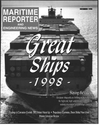
Page 8: of Maritime Reporter Magazine (December 1998)
Read this page in Pdf, Flash or Html5 edition of December 1998 Maritime Reporter Magazine
INVESTMENT IN DESIGN
Europeans Hang On With Technology by David Tinsley, technical editor
European shipbuilding's ever- slackening hold on the indigenous market for the larger types of cargo-carrying vessel has been emphasized by recent contracts placed in Japan and South Korea by owners from communities tradi- tionally loyal to national industries where the capability, if not the will, has been retained to build high- capacity crude carriers and bulk- ers.
In the face of domestic economic adversity, Korean shipbuilders in particular have demonstrated for- titude of an order which tran- scends any advantageous position conferred by a weakened currency.
But time will tell whether struc- tural changes to the industry in other parts of eastern Asia, precip- itated by economic crises in the region, will impact on the market and hence on the seemingly inex- orable drift of business towards the
Orient.
Despite Europe's loss of produc- tion of the most populous cate- gories of deepsea merchant vessel, sectors of the industry have dis- played a tremendous business resilience, maintaining markets and competitiveness through a focus on technology and production processes.
Cruise ship construction is a case in point, but world-class effi- ciency in turning out altogether more modest vessel types is also clearly evident.
Dutch shipbuilding, in particu- lar, has demonstrated a level of efficiency in small-vessel construc- tion on a scale scarcely matched in any other part of the world, which stems not only from technical and design skills, but from organiza- tional methods, notably a far-sight- ed approach to outsourcing coupled with investments in areas of spe- cialization.
While welcoming the impending abolition of EU subsidies, there is a growing feeling in those quarters that the European Commission needs to re-think its shipbuilding policies so as to better enable the more dynamic sectors of the indus- try to thrive and contribute to the wider economic well-being.
It could be said that the EU would do well to nurture such areas of enterprise and competence in the face of growing internation- al uncertainty. "It is striking that capacity con- trol of the European shipbuilding industry is still an issue," observes
Central Industry Group (CIG), a
Dutch company heavily involved in ship steel fabrication, shipbuild- ing, design and marine engineer- ing. "If the sector is to flourish and blossom, the policy to be pursued should be proactive and stimulat- ing rather than reactive, subsidy- oriented and restrictive of capaci- ty."
The industry in the Netherlands considers itself strong enough to maintain its position in a globally subsidy-free environment.
The manner in which firms have retained viability and competitive- ness should perhaps be better appreciated by the Commission, which often models its policies on
Japan, despite fundamental differ- ences between the industries in
Japan and Europe as regards generic ship type focus, unit scale, corporate diversification and ship- building profitability. "It would be better if the EC were to follow the top segment of productive European shipyards and to benchmark these," suggests
CIG. "From a conceptual perspec- tive, the top segment of the
European shipyard industry might well be better prepared for the future than their Japanese col- leagues," it suggests. "After all, the shipyard of the future is likely to be an assembly company with a strong business orientation on project development and a clear operational focus on project management, rather than an old-fashioned, inflexible, capi- tal-absorbing and labor-intensive ship's plant.
This new type of shipyard makes use of a network of suppli- ers each specializing in his own product and often working for var- ious shipyards." "Such a structure of the indus- try will lower the risk profile of both the shipyards and their net- work of suppliers," asserts
Groningen-based CIG. The north
Netherlands, where a cluster of independent shipyards, section builders, materials and equipment suppliers, function in an integrat- ed manner, provides a showcase for such arrangements.
Dutch fortitude: 2,800-dwt feedership Heereplein on ice passage following delivery by Tille
Scheepsbouw, part of the Central Industry Group (CIG) 8 Maritime Reporter & Engineering News

 7
7

 9
9
